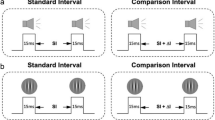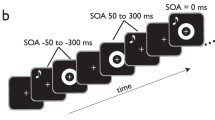Abstract
This study assessed possible cross-modal transfer effects of training in a temporal discrimination task from vision to audition as well as from audition to vision. We employed a pretest–training–post-test design including a control group that performed only the pretest and the post-test. Trained participants showed better discrimination performance with their trained interval than the control group. This training effect transferred to the other modality only for those participants who had been trained with auditory stimuli. The present study thus demonstrates for the first time that training on temporal discrimination within the auditory modality can transfer to the visual modality but not vice versa. This finding represents a novel illustration of auditory dominance in temporal processing and is consistent with the notion that time is primarily encoded in the auditory system.


Similar content being viewed by others
References
Banai K, Ortiz JA, Oppenheimer JD, Wright BA (2010) Learning two things at once: differential constraints on the acquisition and consolidation of perceptual learning. Neuroscience 165:436–444
Brainard DH (1997) The psychophysics toolbox. Spat Vis 10:433–436
Buhusi CV, Meck WH (2009) Relativity theory and time perception: single or multiple clocks? PLoS One 4:e6268
Creelman CD (1962) Human discrimination of auditory duration. J Acoust Soc Am 34:582–593
Fahle M, Edelman S (1993) Long–term learning in vernier acuity: effects of stimulus orientation, range and of feedback. Vis Res 33:397–412
Gibbon J, Church RM, Meck WH (1984) Scalar timing in memory. Ann NY Acad Sci 423:52–77
Grondin S (1993) Duration discrimination of empty and filled intervals marked by auditory and visual signals. Percept Psychophys 54:383–394
Grondin S, Rammsayer T (2003) Variable foreperiods and temporal discrimination. Q J Exp Psychol 56A:731–765
Grondin S, Ulrich R (2011) Duration discrimination performance: no cross–modal transfer from audition to vision even after massive perceptual learning. In: Vatakis A, Esposito A, Giagkou M, Cummins F, Papadelis G (eds) Multidisciplinary aspects of time and time perception, vol 6789. Lecture Notes in Computer Science, Springer Berlin, pp 92–100
Guttman SE, Gilroy LA, Blake R (2005) Hearing what the eyes see: auditory encoding of visual temporal sequences. Psych Sci 16:228–235
Ivry RB, Schlerf JE (2008) Dedicated and intrinsic models of time perception. Trends Cogn Sci 12:273–280
Kanai R, Lloyd H, Bueti D, Walsh V (2011) Modality–independent role of the primary auditory cortex in time estimation. Exp Brain Res 209:465–471
Karmarkar UR, Buonomano DV (2003) Temporal specificity of perceptual learning in an auditory discrimination task. Learn Mem 10:141–147
Karmarkar UR, Buonomano DV (2007) Timing in the absence of clocks: encoding time in neural network states. Neuron 53:427–438
Lapid E, Rammsayer T, Ulrich R (2008) On estimating the difference limen in duration discrimination tasks: a comparison of the 2AFC and the reminder task. Percept Psychophys 70:291–305
Lapid E, Ulrich R, Rammsayer T (2009) Perceptual learning in auditory temporal discrimination: no evidence for a cross–modal transfer to the visual modality. Psychon Bull Rev 16:382–389
Meegan DV, Aslin RN, Jacobs RA (2000) Motor timing learned without motor training. Nat Neurosci 3:860–862
Nagarajan SS, Blake DT, Wright BA, Byl N, Merzenich MM (1998) Practice-related improvements in somatosensory interval discrimination are temporally specific but generalize across skin location, hemisphere, and modality. J Neurosci 18:1559–1570
Pelli DG (1997) The VideoToolbox software for visual psychophysics: transforming numbers into movies. Spat Vis 10:437–442
Penney TB, Gibbon J, Meck WH (2000) Differential effects of auditory and visual signals on clock speed and temporal memory. J Exp Psychol Hum Percept Perform 26:1770–1787
Rammsayer TH (1994) Effects of practice and signal energy on duration discrimination of brief auditory intervals. Percept Psychophys 55:454–464
Repp BH, Penel A (2002) Auditory dominance in temporal processing: new evidence from synchronization with simultaneous visual and auditory sequences. J Exp Psychol Hum Percept Perform 28:1085–1099
Shiu L, Pashler H (1992) Improvement in line orientation discrimination is retinally local but dependent on cognitive set. Percept Psychophys 52:582–588
Treisman M, Faulkner A, Naish PLN, Brogan D (1990) The internal clock: evidence for a temporal oscillator underlying time perception with some estimates of its characteristic frequency. Percept 19:705–743
Ulrich R, Nitschke J, Rammsayer T (2006) Crossmodal temporal discrimination: assessing the predictions of a general pacemaker–counter model. Percept Psychophys 68:1140–1152
Warm JS, Stutz RM, Vassolo PA (1975) Intermodal transfer in temporal discrimination. Percept Psychophys 18:281–286
Wearden JH, Edwards H, Fakhri M, Percival A (1998) Why ‘‘sounds are judged longer than lights’’: application of a model of the internal clock in humans. Q J Exp Psychol 51B:97–120
Welch RB, DuttonHurt LD, Warren DH (1986) Contributions of audition and vision to temporal rate perception. Percept Psychophys 39:294–300
Wright BA, Buonomano DV, Mahncke HW, Merzenich MM (1997) Learning and generalization of auditory temporal–interval discrimination in humans. J Neurosci 17:3956–3963
Zakay D, Block RA (1997) Temporal cognition. Curr Dir Psychol Sci 6:12–16
Acknowledgments
This study was supported by the Deutsche Forschungsgemeinschaft (UL 116/12-1). We thank Teresa Birngruber and Linda Idelberger for assistance in data acquisition.
Author information
Authors and Affiliations
Corresponding author
Rights and permissions
About this article
Cite this article
Bratzke, D., Seifried, T. & Ulrich, R. Perceptual learning in temporal discrimination: asymmetric cross-modal transfer from audition to vision. Exp Brain Res 221, 205–210 (2012). https://doi.org/10.1007/s00221-012-3162-0
Received:
Accepted:
Published:
Issue Date:
DOI: https://doi.org/10.1007/s00221-012-3162-0




